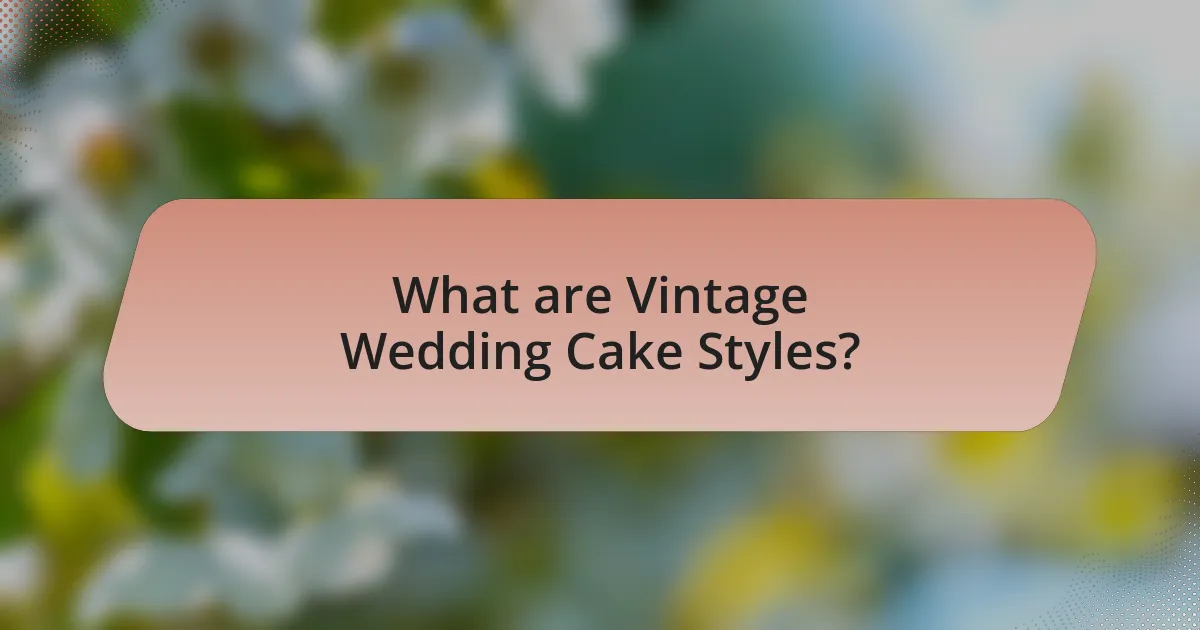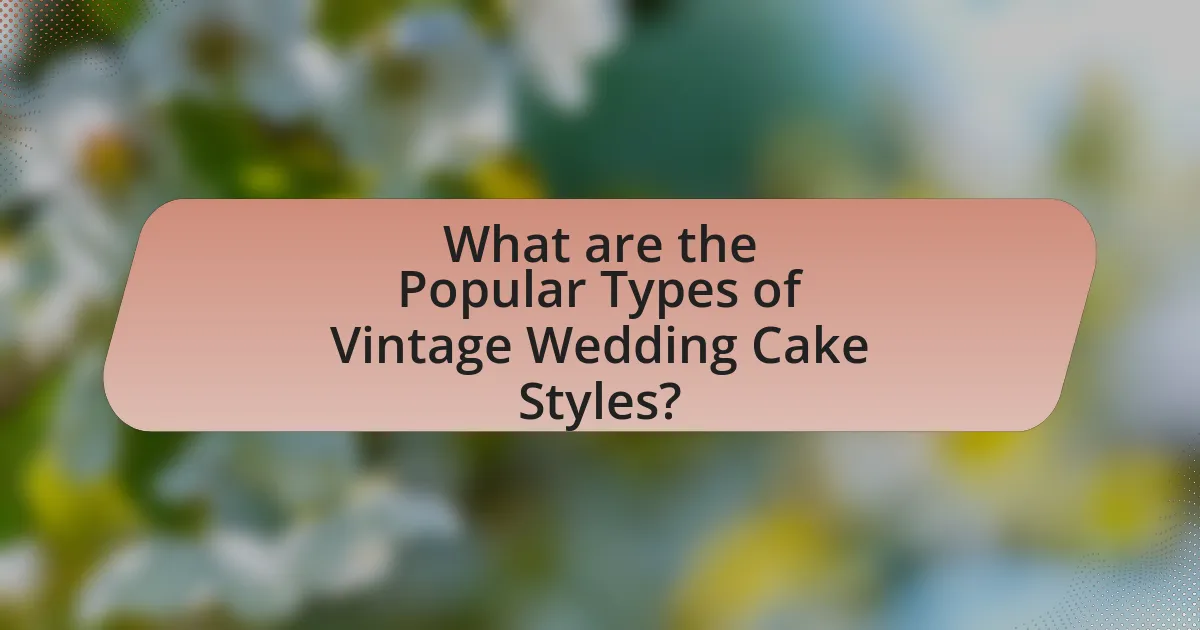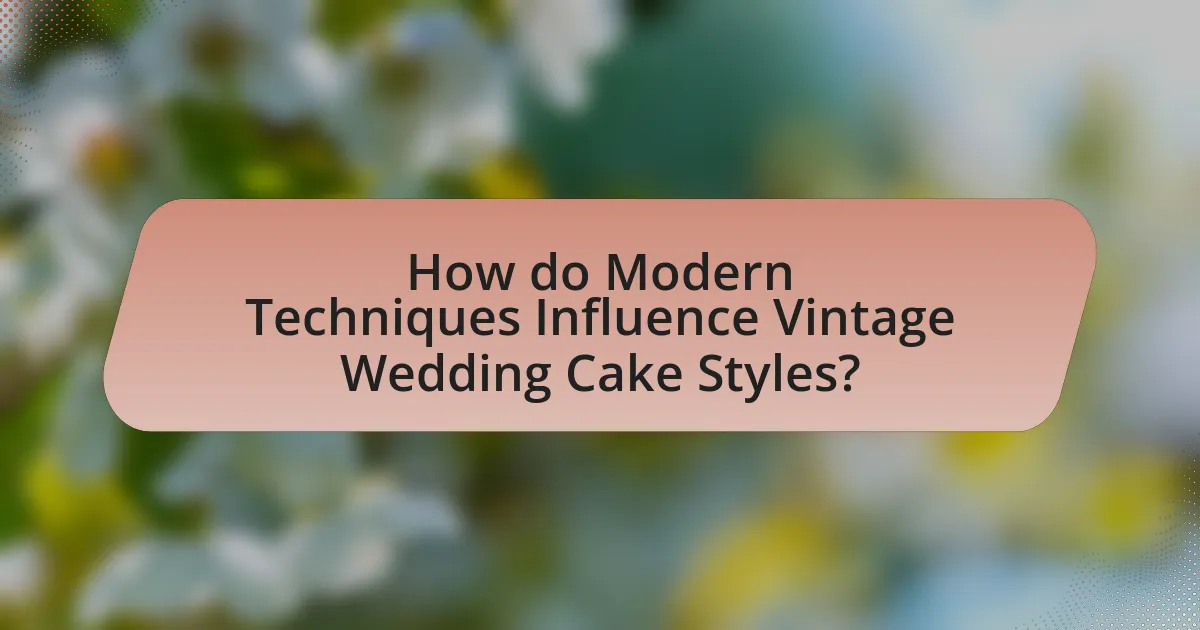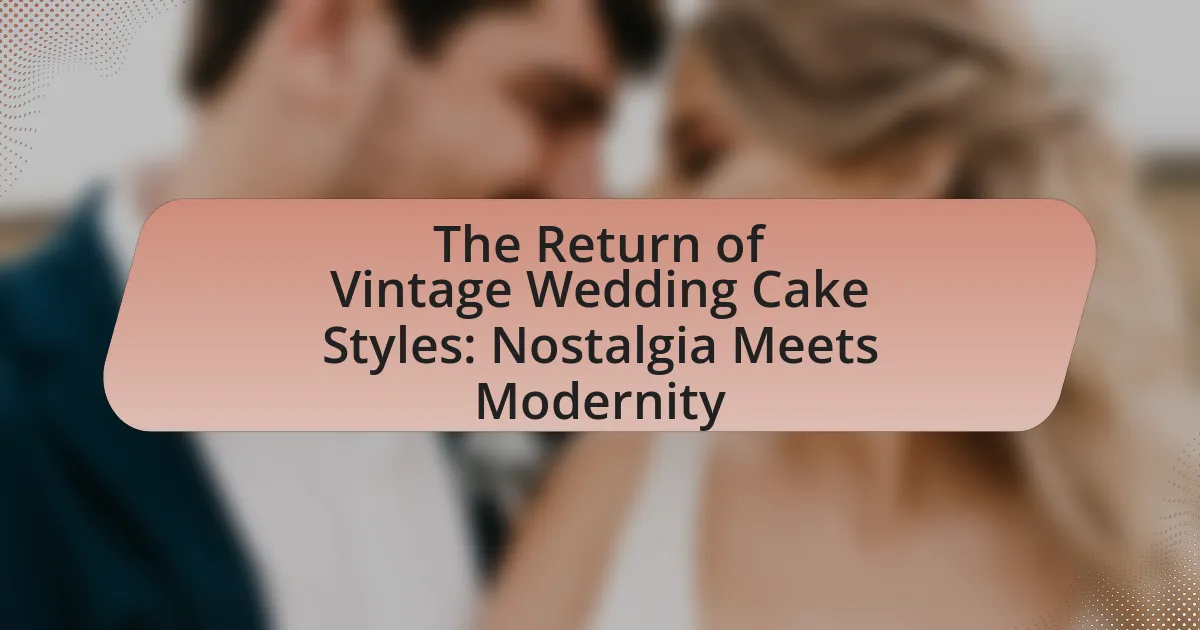Vintage wedding cake styles are defined by their intricate designs and historical influences, often reflecting aesthetics from eras such as the Victorian and Art Deco periods. These cakes typically feature ornate decorations, multi-tiered structures, and traditional flavors, contrasting with modern minimalist designs. The resurgence of vintage styles is driven by a desire for nostalgia and personalization in weddings, with couples increasingly opting for classic elements that evoke sentimental memories. Key characteristics include the use of floral motifs, muted color palettes, and modern baking techniques that enhance traditional aesthetics, allowing for a blend of vintage charm and contemporary innovation.

What are Vintage Wedding Cake Styles?
Vintage wedding cake styles are characterized by their intricate designs, often inspired by historical periods such as the Victorian era, Art Deco, or the 1920s. These cakes typically feature ornate decorations, including lace patterns, floral motifs, and vintage color palettes like pastels or muted tones. The use of traditional techniques, such as fondant draping and hand-piped details, further enhances their nostalgic appeal. Historical references indicate that vintage cakes often prioritize elegance and craftsmanship, reflecting the social customs and aesthetics of their respective eras.
How do Vintage Wedding Cake Styles differ from Modern Styles?
Vintage wedding cake styles differ from modern styles primarily in their design aesthetics and decoration techniques. Vintage cakes often feature intricate detailing, such as lace patterns, floral motifs, and hand-piped decorations, reflecting craftsmanship from earlier eras, particularly the Victorian and Edwardian periods. In contrast, modern wedding cakes tend to embrace minimalism, with clean lines, geometric shapes, and a focus on bold colors or simple textures, often utilizing fondant for a sleek finish.
The historical context supports this distinction, as vintage cakes were typically multi-tiered and adorned with elaborate embellishments, while modern cakes prioritize simplicity and personalization, often incorporating unique flavors and contemporary themes. This evolution in cake design illustrates a shift from traditional artistry to a more streamlined, individualized approach in contemporary weddings.
What historical influences shaped Vintage Wedding Cake Styles?
Vintage wedding cake styles were shaped by historical influences such as the Victorian era’s emphasis on elaborate designs, the introduction of sugar paste in the 19th century, and the post-World War II trend of simpler, more personal cakes. The Victorian era popularized multi-tiered cakes adorned with intricate decorations, reflecting the period’s opulence. The use of sugar paste allowed for more detailed and artistic designs, which became a hallmark of wedding cakes. After World War II, there was a shift towards more modest and personalized cakes, influenced by changing social norms and the desire for intimacy in celebrations. These historical trends collectively inform the aesthetic and cultural significance of vintage wedding cakes today.
What are the key characteristics of Vintage Wedding Cake Styles?
Vintage wedding cake styles are characterized by intricate designs, often featuring lace patterns, floral embellishments, and a multi-tiered structure. These cakes typically utilize classic flavors such as fruitcake or sponge, reflecting traditional baking methods. The aesthetic often incorporates muted color palettes, pastel shades, and vintage-inspired decorations like sugar flowers or edible pearls, which evoke a sense of nostalgia. Historical influences from the Victorian and Edwardian eras are evident in the ornate detailing and craftsmanship, making these cakes not only a dessert but also a centerpiece that embodies the elegance of bygone eras.
Why is there a resurgence of Vintage Wedding Cake Styles?
The resurgence of vintage wedding cake styles is primarily driven by a growing desire for nostalgia and personalization in modern weddings. Couples increasingly seek to incorporate elements that reflect their unique stories and heritage, leading to a preference for classic designs that evoke sentimental memories. This trend is supported by the rise of social media platforms, where visually appealing vintage cakes gain popularity through sharing and inspiration, reinforcing their appeal. Additionally, the craftsmanship associated with vintage styles, such as intricate detailing and traditional baking techniques, resonates with couples who value artisanal quality over mass production.
What role does nostalgia play in the popularity of Vintage Wedding Cake Styles?
Nostalgia significantly enhances the popularity of Vintage Wedding Cake Styles by evoking cherished memories and emotions associated with past traditions. This emotional connection drives couples to seek out vintage designs that reflect a sense of history and personal significance, often inspired by family heirlooms or cultural heritage. Research indicates that nostalgia can increase consumer preference for products that remind individuals of positive past experiences, making vintage cakes appealing for their aesthetic and sentimental value. The resurgence of vintage styles in wedding planning aligns with a broader trend where couples prioritize personalization and meaningful experiences, further solidifying nostalgia’s role in this culinary choice.
How do modern couples incorporate Vintage Wedding Cake Styles into their weddings?
Modern couples incorporate Vintage Wedding Cake Styles into their weddings by selecting designs that reflect historical aesthetics, such as intricate lace patterns, floral motifs, and classic tiered structures. These couples often choose flavors and ingredients that were popular in past decades, enhancing the nostalgic experience. Additionally, they may use vintage cake stands and decorative elements that evoke a sense of history, further integrating the vintage theme into their overall wedding decor. This trend aligns with the growing interest in personalized and unique wedding experiences, as evidenced by the rise in popularity of vintage-themed weddings, which accounted for approximately 30% of all weddings in recent years.

What are the Popular Types of Vintage Wedding Cake Styles?
Popular types of vintage wedding cake styles include the classic tiered cake, the rustic naked cake, and the elegant lace cake. The classic tiered cake often features intricate designs and multiple layers, reflecting traditional wedding aesthetics from the early 20th century. The rustic naked cake, which has minimal frosting and showcases the cake layers, draws inspiration from the farm-to-table movement and is popular for its simplicity and natural look. The elegant lace cake incorporates delicate lace patterns made from fondant or icing, reminiscent of vintage bridal gowns, and adds a touch of sophistication. These styles are favored for their nostalgic appeal and ability to blend seamlessly with modern wedding themes.
Which Vintage Wedding Cake Styles are trending today?
The trending vintage wedding cake styles today include art deco, rustic naked cakes, and floral designs. Art deco cakes are characterized by geometric patterns and metallic accents, reflecting the elegance of the 1920s. Rustic naked cakes, often adorned with fresh fruits and flowers, evoke a charming, countryside feel reminiscent of simpler times. Floral designs, featuring intricate sugar flowers or real blooms, capture the romantic essence of vintage weddings. These styles resonate with couples seeking to blend nostalgia with contemporary aesthetics, as evidenced by their popularity in recent wedding trends and social media showcases.
What are the defining features of Classic Buttercream Cakes?
Classic Buttercream Cakes are characterized by their rich, creamy frosting made primarily from butter and powdered sugar, which provides a smooth and velvety texture. This type of cake typically features a light and fluffy sponge, often vanilla or chocolate, that complements the sweetness of the buttercream. The defining features also include a simple yet elegant decoration style, often adorned with fresh flowers or minimalistic piping, reflecting a timeless aesthetic. Historically, buttercream has been a popular choice for wedding cakes since the late 19th century, making it a nostalgic element in modern vintage cake designs.
How do Fondant Cakes reflect Vintage Aesthetics?
Fondant cakes reflect vintage aesthetics through their intricate designs, smooth finishes, and the ability to mimic traditional cake styles. The use of fondant allows for detailed decorations such as lace patterns, floral motifs, and vintage color palettes that evoke nostalgia. Historically, fondant became popular in the 19th century, aligning with the Victorian era’s emphasis on elaborate cake designs, which further solidifies its connection to vintage aesthetics. The revival of these styles in modern weddings showcases a blend of nostalgia and contemporary techniques, making fondant cakes a prominent choice for couples seeking to honor classic elegance.
What unique designs are associated with Vintage Wedding Cakes?
Unique designs associated with vintage wedding cakes include intricate lace patterns, hand-painted floral motifs, and tiered structures that often feature a combination of pastel colors and gold accents. These designs reflect the elegance of bygone eras, particularly the Victorian and Edwardian periods, where cakes were adorned with elaborate decorations and craftsmanship. Historical references indicate that the use of sugar flowers and detailed piping techniques became popular in the late 19th century, showcasing the artistry involved in cake design during that time.
How do floral decorations enhance Vintage Wedding Cake Styles?
Floral decorations enhance Vintage Wedding Cake Styles by adding a touch of elegance and nostalgia that complements the overall aesthetic. These decorations often feature blooms that reflect the historical context of vintage designs, such as roses, peonies, and hydrangeas, which were popular in past eras. The use of fresh or edible flowers not only elevates the visual appeal but also connects the cake to the romantic themes often associated with vintage weddings. Additionally, floral arrangements can be tailored to match the color palette and style of the wedding, reinforcing the cohesive look that vintage themes embody. This integration of floral elements is supported by trends in wedding design, where 70% of couples opt for floral accents to personalize their cake, demonstrating their significant role in enhancing vintage styles.
What are the common color palettes used in Vintage Wedding Cakes?
Common color palettes used in vintage wedding cakes include soft pastels, muted tones, and rich jewel colors. Soft pastels such as blush pink, lavender, and mint green evoke a romantic and nostalgic feel, often associated with vintage aesthetics. Muted tones like dusty rose, sage green, and pale blue provide a subtle elegance, while rich jewel colors such as deep burgundy, emerald green, and navy blue add a touch of sophistication and opulence. These palettes reflect historical influences and are often complemented by intricate designs and vintage-inspired decorations, reinforcing their connection to traditional wedding themes.

How do Modern Techniques Influence Vintage Wedding Cake Styles?
Modern techniques significantly influence vintage wedding cake styles by enhancing design precision and expanding creative possibilities. Techniques such as airbrushing, fondant sculpting, and 3D printing allow bakers to replicate intricate vintage designs with greater accuracy and detail. For instance, airbrushing can create soft gradients and realistic textures that were difficult to achieve with traditional methods. Additionally, the use of edible printing technology enables the reproduction of vintage patterns and images directly onto cake surfaces, merging nostalgia with contemporary aesthetics. This combination of modern tools and vintage inspiration results in cakes that honor traditional styles while incorporating innovative elements, thus appealing to a broader range of couples seeking both classic and unique designs for their weddings.
What modern baking techniques are used to create Vintage Wedding Cakes?
Modern baking techniques used to create Vintage Wedding Cakes include fondant application, airbrushing, and the use of edible lace. Fondant allows for smooth, elegant finishes that mimic the intricate designs of vintage cakes, while airbrushing enables bakers to achieve soft color gradients and detailed patterns reminiscent of classic styles. Edible lace, made from a mixture of sugar and other ingredients, adds delicate, vintage-inspired embellishments that enhance the overall aesthetic. These techniques combine traditional aesthetics with contemporary methods, ensuring that vintage wedding cakes meet modern standards of taste and presentation.
How does technology impact the design of Vintage Wedding Cakes?
Technology significantly impacts the design of Vintage Wedding Cakes by enabling intricate designs and precision that were previously unattainable. Advanced tools such as 3D printers allow cake designers to create detailed decorations that mimic vintage styles, while digital design software facilitates the planning and visualization of complex patterns. Additionally, modern baking techniques, including temperature-controlled ovens and high-quality ingredients, enhance the structural integrity and flavor of these cakes, ensuring they not only look beautiful but also taste exceptional. The integration of technology in cake design has led to a resurgence of vintage aesthetics, as artisans can now replicate historical designs with greater accuracy and creativity.
What are the benefits of using modern ingredients in Vintage Wedding Cakes?
Using modern ingredients in vintage wedding cakes enhances flavor, texture, and dietary inclusivity. Modern ingredients, such as high-quality cocoa, natural flavor extracts, and gluten-free alternatives, improve taste profiles and cater to diverse dietary needs. For instance, the use of organic ingredients can elevate the cake’s overall quality and appeal, while innovative techniques like sous-vide baking can ensure consistent moisture and texture. Additionally, modern food science allows for the creation of healthier options without sacrificing the traditional aesthetic, making vintage cakes more accessible to contemporary audiences.
How can couples blend Vintage and Modern elements in their wedding cakes?
Couples can blend vintage and modern elements in their wedding cakes by incorporating classic designs with contemporary techniques and flavors. For instance, they can choose a traditional tiered cake structure adorned with intricate lace patterns or floral motifs, which are characteristic of vintage styles, while using modern color palettes like metallics or pastels to give it a fresh look. Additionally, couples can opt for unique flavor combinations that reflect current trends, such as salted caramel or matcha, while maintaining a classic buttercream or fondant finish. This approach allows for a harmonious fusion of nostalgia and modernity, appealing to both traditional and contemporary tastes.
What are some examples of successful Vintage-Modern cake combinations?
Successful Vintage-Modern cake combinations include the classic red velvet cake paired with contemporary geometric designs, and a traditional fruitcake adorned with sleek, minimalist fondant. These combinations effectively blend nostalgic flavors with modern aesthetics, appealing to a wide range of tastes. For instance, the red velvet cake’s rich history dates back to the 1920s, while geometric designs reflect current trends in cake decoration, creating a harmonious balance between past and present. Similarly, fruitcake, often associated with vintage weddings, can be modernized through the use of clean lines and elegant finishes, showcasing how traditional elements can be reimagined in a contemporary context.
How can flavor choices reflect both Vintage and Modern trends?
Flavor choices can reflect both Vintage and Modern trends by incorporating traditional ingredients and techniques alongside contemporary flavor profiles and presentation styles. For instance, vintage wedding cakes often featured classic flavors like vanilla, almond, and fruitcake, which evoke nostalgia and historical significance. In contrast, modern trends may introduce innovative flavors such as salted caramel, matcha, or exotic spices, appealing to current tastes and preferences. This blend allows bakers to honor traditional recipes while also catering to evolving consumer desires, creating a harmonious balance that resonates with both nostalgic sentiments and modern culinary exploration.
What practical tips should couples consider when choosing a Vintage Wedding Cake?
Couples should prioritize authenticity and personal style when choosing a Vintage Wedding Cake. Selecting a cake that reflects their unique story and the era they wish to emulate is essential. For instance, couples can research popular vintage cake designs from specific decades, such as the intricate lace patterns of the Victorian era or the bold colors of the 1970s. Additionally, they should consider flavor combinations that were popular during those times, such as fruitcake or chocolate ganache, to enhance the nostalgic experience. Finally, sourcing ingredients locally and opting for traditional baking methods can further align the cake with vintage aesthetics, ensuring both taste and presentation resonate with the chosen theme.
How can couples ensure their Vintage Wedding Cake fits their wedding theme?
Couples can ensure their Vintage Wedding Cake fits their wedding theme by selecting design elements that reflect the overall aesthetic of their event. This includes choosing colors, patterns, and decorations that align with the vintage style, such as lace, floral motifs, or antique-inspired cake toppers. Additionally, couples should consider the flavor and texture of the cake, opting for traditional recipes that evoke nostalgia, like fruitcake or sponge cake, which were popular in past eras. Research indicates that incorporating these elements not only enhances the visual appeal but also creates a cohesive atmosphere that resonates with the vintage theme, as seen in the resurgence of vintage styles in contemporary weddings.
What are the best practices for selecting a baker for a Vintage Wedding Cake?
To select a baker for a Vintage Wedding Cake, prioritize bakers with experience in vintage styles and a strong portfolio showcasing their work. Research local bakers who specialize in vintage designs, as they will understand the intricacies of techniques like fondant draping and intricate piping, which are often essential for vintage aesthetics. Schedule tastings to evaluate flavor and texture, ensuring the cake meets your expectations. Additionally, read reviews and ask for references to confirm the baker’s reliability and quality of service. According to a survey by The Knot, 75% of couples consider cake tastings crucial in their selection process, highlighting the importance of this step.
